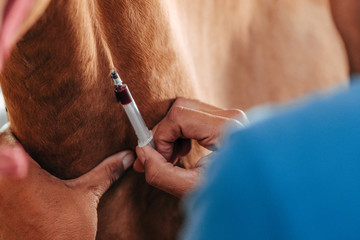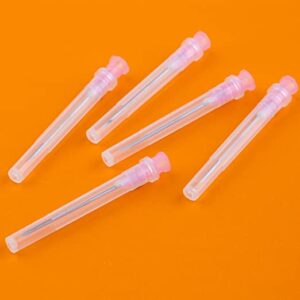Yes, I am a trainer’s wife but there are a couple of things down at the barn that I loathe. One of the them is hooking up a trailer. And the second is giving a penicillin shot.
Penicillin is a potent, antibiotic often used in horses against a variety of pathogenic organisms. I figure my reason for hating these sometimes necessary tasks is because any mistake I make in doing either, would likely result in the death of an animal.
A trailer that comes unhooked on the highway is dangerous to me, other drivers and the precious cargo I have in the back. A penicillin shot gone wrong can be potentially and immediately fatal for my horse. For that reason, I decided to research some little known facts about the drug and helpful tips for administering penicillin:
Steps for Administering Penicillin to Your Horse
• I’m sure I don’t need to tell you that you must always ensure you give penicillin shot with a sterile needle and syringe, (never reuse a needle because a contaminated needle can easily introduce an infection into a horse.) But it may be helpful to know that the size of the needle depends on the medication being injected. A large-diameter needle (18 gauge) works best with thick solutions such as penicillin, while a smaller-diameter needle (20 to 21 gauge) is good for thin, watery solutions.


• Most IM shots are given to adult horses with a 1-1/2-inch needle so that the medication is injected deep into the muscle mass. Foals are usually given IM injections with a 1-inch needle.
• Penicillin is very commonly administered to horses in a formulation known as penicillin procain G. The procaine is a local anesthetic which is related to lidocaine, novacaine and believe it or not, cocaine.
• When administered properly, penicillin usually does not result in a problem. But care must be to ensure procaine penicillin is always injected intramuscularly. If it is administered into IV or into a vein, it can be dangerous and potentially fatal for your horse. If the drug is accidentally injected into the horse’s bloodstream, the procaine goes directly to the horse’s brain and causes the animal to tremble violently and throw itself over backwards. There is no antidote for this reaction and it is not only dangerous to the horse, it is extremely dangerous for bystanders.
For that reason, after you have inserted the needle into a designated injection site, you must pull back on the syringe plunger a bit to make sure there is no blood in the syringe. (Or if you prefer to put the needle in first and secondly, attach the syringe filled with medicine, watch the hub of the needle to see if it fills with blood. If blood is present, remove the needle and start over.
Never follow through with the injection if you see blood! When you can pull back on the plunger and no blood appears, it’s safe to inject the penicillin into your horse.
• Penicillin also has the ability to trigger allergic or anaphylactic reactions in certain animals that can occur unpredictably with varying intensity. Should this happen, discontinue use of the penicillin and call a veterinarian immediately. Allergic reactions typically require previous exposure to the drug and then the problem is manefested by hives and head swelling. Occasionally, it can also result in massive constriction of the airwaves and sudden death.
Conclusion
As there are many great antibiotics are available to your veterinarian these days, it’s possible penicillin may not be prescribed in unfortunate circumstances that affect your horse’s well being. But if it is, just remember that procaine penicillin G is a very beneficial drug to use in the war against wound infections, secondary bacterial infections in respiratory diseases, and various other injuries or diseases. Always consult with your veterinarian before administering a penicillin regime so you clearly understand this drug’s proper dosages, frequency of administration and withdrawal times.




12 thoughts on “Administering Penicillin”
Thanks Jenn
Touch wood, I have not had to do this. This was extremely informative and will be sure to keep it on hand if the occasion ever arrived. I had no idea. BTW … congrates!!
Thanks for the great information Jen! Although we can save a lot of money by administering penicillin ourselves, it is not a good idea to do it unless we feel 100% confident in doing so. It’s just not worth the risk. Recently, I had to administer penicillin to one of my mares and because I live out in the country, far away from my vet, I decided to learn how to do it properly. I asked my vet to teach me how to do it, as if I was a vet student. My vet happily showed me how and gave me all the necessary information should something go wrong, as you described in your article. I had a very cooperative mare, which is great when you are learning a new skill, and everything went very smoothly.
It is also very important to make sure you split up your dosage when administering. No more than 10 to 15 cc of product per site. I have had indents or muscle lumps left behind years later from injecting too much penicillin in one spot and some have been done by a Vet.
Thanks! I would like to add that it’s best to have someone experienced show where the large muscles are in a horse, and where the major veins and arteries are. Knowing the sweet spots makes it much easier to get it right and it’s safer for both horse and handler. There are methods of giving shots which minimize pain. As with any antibiotic, a series of injections should be given (as per label usage) so that the bugs don’t develop antibiotic resistance.
I have given penicillin shots for years without a problem but will never do it again. The last time I gave a shot to my gelding I followed all the steps that I did for years and things went wrong FAST. There was no blood when I pulled back so I gave the shot seconds after his head went up his eyes got big and he freaked out. He almost demolished the stalls in the barn. It scared the @#$% out of me. As fast as it happened it was over. I called my vet immediatly and told him what happened. He came and checked him over and said that some of the penicillin must have gotten into a small vein that is in the muscle. I will never use penicillin again, I always ask if the is anything else I can use. It was a great post though and I love this blog. I hope no one else has to go through what I did.
I injected penicillin in my horse today and he acted real crazy. Just like Kims. I guess some went in some small veins, but let me tell ya’ll it scare the hell out of me!!!! Now I’m scare to use penicillin again….
Is there a difference between equine and cattle penicillins? My husband asked for penicillin for a horse and the clerk gave him Dura-Pen Penicillin G Procaine that states that it is “for use only in beef cattle.”
Pingback: Anaphylactic shock - Page 2
I have been told by my ferrier that vets haven’t used penicillin in two years that it is two dangerous. I have always used pro-pen-g for treatment of infected wounds. Was this comment justified or not. He currently has a horse with a severe wound infection on the left rear knee that has rendered the lame horse and refuses to use any penicillin type. The wound is hot and severely infected.
A good lesson indeed, i’ve always wanted to hear from experts about this medication for horses. Le ka moso betsho!
I have been using penicillin procaine G short-acting on my horse for 5 days 33 CC’s twice a day for an upper respiratory infection the vet told me to use it for 10 days yet everything I’m reading says no more than 7 days its making me nervous any suggestions?
I am a trainer of 40 years handling many hundreds of horses, from the track to the jumper rings, chasing cows to breeding operations…. I can’t count how many times I have administered Pen G procaine and had only one previous incedent with a Morgan mare whom I was prepared with an epinephrine shot, she recovered in just a few minutes and was fine, that was 30 years ago.
Yesterday was a very bad day for me, I injected my wifes mare with Pen G Procaine, This was the last of 3 days of treatment prescribed by our vet, following a pull back and no blood, I remind you I am a professional and have adminitered hundereds of shots, 1 minute after the IM injection she starts to react, I know immediately what is happening but it turns violant quickly and the mare goes down, I told my wife to call the vet who just left minutes ago and I got the mare to settle down, however by 5 minutes she was gone. I’m so upset, I loved her, I know it was an accident but I killed her. not coping well this time.